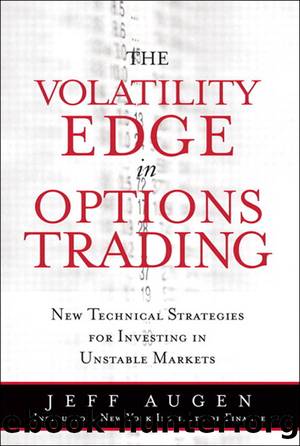Volatility Edge in Options Trading : New Technical Strategies for Investing in Unstable Markets (9780132703680) by Augen Jeff

Author:Augen, Jeff
Language: eng
Format: epub
Publisher: Prentice Hall
Published: 2008-11-14T16:00:00+00:00
Figure 5.9. One-year price spike history for MHS (02/21/2006â02/16/2007). Standard deviations measured against the 20-day volatility window are displayed on the y-axis, and trading days on the x-axis.
Unlike USNA, MedcoHealth does not react to earnings announcements with predictably large spikes. During the time frame of the chart, earnings produced spikes of 4.74, 2.09, 2.58, and 0.52 standard deviations. The only outstanding member of the list was the large upward spike coincident with the March 1, 2006 earnings release and visible on the left side of the chart. The chart does not reveal any particular pattern or information that might be used to time entry into a long position. However, the high frequency of significant price spikes makes entry timing a minor issue.
During the trading year shown in Figure 5.9, MHS experienced 24 spikes over 2 standard deviations but only four spikes greater than 4. It is also beneficial to the analysis to rank stocks according to the size and frequency of multiday price spikes. For this purpose we can create composite days composed of a fixed number of trading days. Suppose in the case of MHS we use three-day composites. Each composite day opens at the opening price of the first day and closes at the closing price of the third day. Volatility calculations should be based on 84 three-day composites per trading year. Multiday spikes are very significant because continual movement in one direction dramatically impacts option prices. Including multiday spikes in our selection criteria helps us select stocks that are likely to experience large multiday price changes. MHS displayed eight multiday spikes (three-day composites) larger than 2 standard deviations during the measurement year.
Summarizing this data leads us to conclude that we can expect a price spike greater than 2 standard deviations twice each month, but a 3 standard deviation spike only once each quarter. We should also expect a three-day, 2 standard deviation spike eight times during the course of a year. The best strategy for such a stock is to purchase short dated straddles. Short dated options make sense for MHS because the price spike frequency is very high, and the spikes tend to be both moderate in size and evenly distributed in time. It is unlikely that we will keep the position open for an extended length of time, waiting for a spike. Straddles are a better choice than strangles because we are focused on generating profit from relatively small moves of the stock. Because MHS is a $60 stock trading with approximately 30% volatility, a standard deviation is approximately $1.15. The spike we are anticipating is likely to fall in the range of $2.30â$3.45â2 to 3 standard deviations. If the stock is trading between two strikes when the position is established, immediately adjacent strike prices are also a good choice. As always, the position should be perfectly delta-neutral at the start, because we are predicting a price spike, not a direction.
We must also consider some choices for position management. The choices fall into two broad categories.
Download
This site does not store any files on its server. We only index and link to content provided by other sites. Please contact the content providers to delete copyright contents if any and email us, we'll remove relevant links or contents immediately.
| Analysis & Strategy | Bonds |
| Commodities | Derivatives |
| Futures | Introduction |
| Mutual Funds | Online Trading |
| Options | Portfolio Management |
| Real Estate | Stocks |
Rich Dad Poor Dad by Robert T. Kiyosaki(6185)
Pioneering Portfolio Management by David F. Swensen(6083)
How To Win Friends and Influence People by Dale Carnegie(4339)
The Money Culture by Michael Lewis(3850)
The Dhandho Investor by Mohnish Pabrai(3564)
The Wisdom of Finance by Mihir Desai(3529)
Liar's Poker by Michael Lewis(3228)
The Intelligent Investor by Benjamin Graham Jason Zweig(2936)
The ONE Thing by Gary Keller(2921)
Mastering Bitcoin: Programming the Open Blockchain by Andreas M. Antonopoulos(2894)
Fooled by Randomness: The Hidden Role of Chance in Life and in the Markets by Nassim Nicholas Taleb(2863)
Rich Dad Poor Dad: What The Rich Teach Their Kids About Money - That The Poor And Middle Class Do Not! by Robert T. Kiyosaki(2836)
How to Win Friends and Influence People by Dale Carnegie(2799)
Investing For Dummies by Eric Tyson(2798)
How to Day Trade for a Living: Tools, Tactics, Money Management, Discipline and Trading Psychology by Andrew Aziz(2786)
Market Wizards by Jack D. Schwager(2544)
Zero Hour by Harry S. Dent Jr. & Andrew Pancholi(2536)
How to Pay Zero Taxes, 2018 by Jeff A. Schnepper(2503)
Rich Dad's Guide to Investing by Robert T. Kiyosaki(2412)
